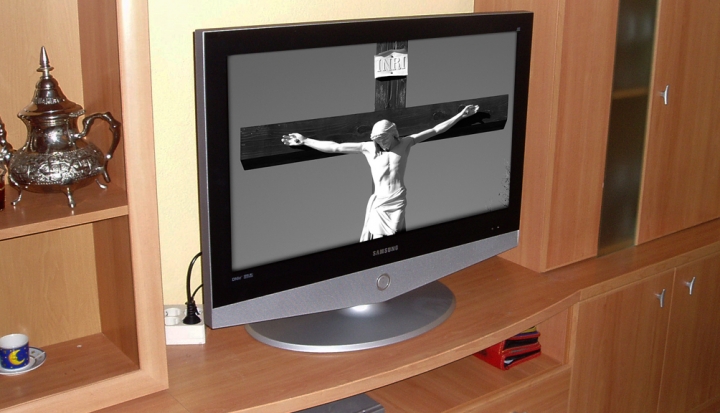Ten years after the release of The Passion of the Christ, a renewed interest in biblical films has landed Jesus back in Hollywood.
On Ash Wednesday, February 25, 2004, The Passion of the Christ was released in theaters in the United States and Australia. By the end of April, Mel Gibson’s graphic account of the passion and death of Jesus was playing in 68 countries, eventually grossing nearly $612 million. The film, starring Jim Caviezel as Jesus, Maia Morgenstern as Mary, and Monica Bellucci as Mary Magdalene, played in American theaters for almost 23 weeks. In a few hours on the first day of its DVD release, more than 2.4 million copies were sold. The film surprised Hollywood and attracted the attention of the industry. All of a sudden, a major film about Jesus mattered.
It is difficult to measure the lasting influence of The Passion of the Christ or any Bible-based film on viewers except anecdotally—or financially, if you are in the film business. I remember approaching a family waiting to see The Passion of the Christ and explaining that because the film was very violent, they might want to reconsider taking their young children. The parents looked at me and said, “But it’s about Jesus. It’s a holy film.”
“Holy” films based on the Bible have been with us almost since the beginning of cinema. The first movie about Jesus seems to have been the French film The Passion Play (La vie et la passion de Jésus Christ) in 1903. Since then, 28 films about Jesus have been released in English or with English subtitles for theater or television. The Passion of the Christ continues to count among the most significant because its success indicated that a contemporary audience is willing to watch Bible films.
The huge success of the History Channel’s 2013 10-hour miniseries The Bible has renewed Hollywood’s interest, especially in biblical films with epic natures. Executive producers Mark Burnett and Roma Downey sold the rights to NBC, and the life of Christ portion was released this February in theaters as Son of God. NBC approved a 12-part sequel, A.D.: Beyond the Bible.
This year we can also look for the big-budget Noah starring Russell Crowe and Exodus from director Ridley Scott. Two films on the resurrection, one aptly entitled Resurrection and the other, a nonstudio multiplatform film, The Resurrection of Jesus Christ, are due out in 2015. Lionsgate has Mary slated for 2015 as well. And due out beyond 2015 are a 10-part television series on the commandments from Harvey Weinstein, another remake of Ben-Hur (based on Lew Wallace’s A Novel of the Christ) from MGM, and The Redemption of Cain from Sony.
Ten years ago, I took a lot of heat for reviewing The Passion of the Christ as a horror film, a genre many assume is immoral. Gibson does employ many horror motifs, but the part of the film that I continue to believe is exploitive, and that some have called pornographic, is the extreme bloody gore of the scourging, the crowning with thorns, and the crucifixion. The brief sliver of the resurrection that Gibson gives us
distorts, to me, the truth of the paschal mystery, that Christ redeemed us by his passion, death, and resurrection.
What I failed to note at the time, and what has continued as part of the film’s lasting legacy, was that many of the horror motifs were visually reinforcing the stereotypes of Jews that have come down through the ages. Some of these included teeth like fangs, throbbing eyes in children, or diseased eyes having been pecked out by birds, showing Jews to be blind.
According to a November 2013 report from the European Union’s Fundamental Rights Agency, there has been a measurable rise in anti-Semitism over the last five years, largely facilitated by social media. An FBI report states that of the 1,340 anti-religious hate crimes committed in 2012 in the United States, 64 percent of the offenses were biased against Jews.
What concerns Rabbi Yitzchok Adlerstein, director of interfaith affairs at the Simon Wiesenthal Center in Los Angeles, is the normalization of negative Jewish stereotypes in films such as The Passion of the Christ. People accept without question things like the image of the crowd that called for Jesus’
death—“Its ferocity, its size, its primitiveness,” explains Adlerstein. “If this were the day before the Passover, the busiest day of the year in terms of preparation, the crowd would have been a very, very small number of people.”
Does The Passion of the Christ still matter? I think it does, in the form of two challenges. First, the market for Bible and faith films that The Passion of the Christ revealed continues to entice producers and sponsors to make such films, just as it challenges producers to move beyond a niche audience, even a big one, so that faith and family films reach the level of art. Second, when it comes to interpreting the Bible for the screen, it is imperative that producers seek to represent Judaism authentically and without visual stereotypes that demonize the Jewish people.
Unfortunately, Gibson’s dramatic and visceral use of negative stereotypes reinforces these images for future generations. This influence matters and is of wide concern if viewers internalize these images into convictions and anti-Semitic actions.
The Passion of the Christ is art, despite the gore and anti-Semitic images. “It is like a moving Caravaggio painting,” one person told me—a very high bar for Hollywood and the burgeoning Christian film industry to reach.
This article appeared in the March 2014 issue of U.S. Catholic (Vol. 79, No. 3, pages 40-41).
Image: Illustration by Angela Cox, Flickr photo cc by valderrama, Flickr photo cc by lindsayshaver













Add comment